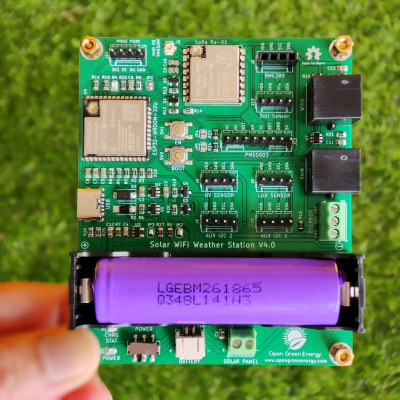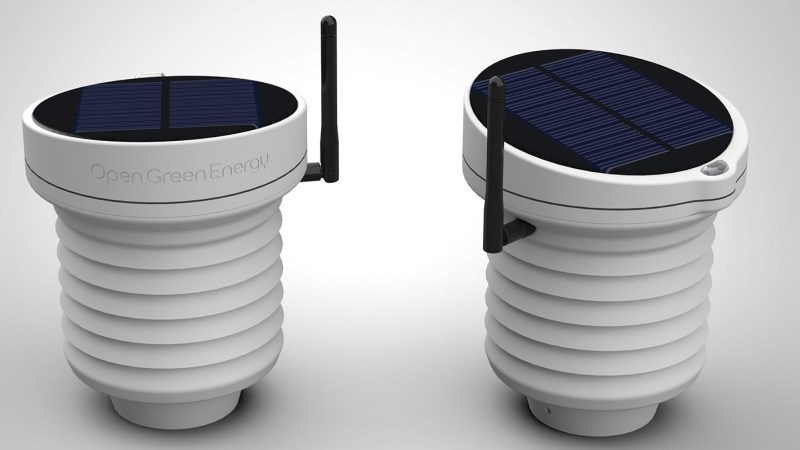[Debasish Dutta] has designed a few weather stations in the past, and this, the fourth version of the system has had many of the feature requests from past users rolled in. The station is intended to be used with an external weather sensor unit, provided by Sparkfun. This handles wind speed and direction, as well as measuring rainfall. A custom PCB hosts an ESP32-WROOM module and an Ai-Thinker Ra-02 LoRa module for control and connectivity respectively. A PMS5003 sits on the PCB to measure those particulate densities, but most sensors are connected with simple 4-way I2C connectors. Temperature, humidity, and pressure are handled by a BME280 module, UV Index (SI1145), visible light (BH1750) even soil humidity and temperature with a cable-mounted SHT10 module.
with simple 4-way I2C connectors. Temperature, humidity, and pressure are handled by a BME280 module, UV Index (SI1145), visible light (BH1750) even soil humidity and temperature with a cable-mounted SHT10 module.
All this is powered by a solar panel, which charges a 18650 cell, and keeps the show running during the darker hours. For debugging and deployment, a USB-C power port can also be used to provide charge. A 3D printed Stevenson screen type enclosure allows the air to circulate amongst the PCB-mounted sensor modules, without hopefully too much moisture making it in there to cause mischief.
On the data collection and visualization side, a companion LoRa receiver module is in progress, which is intended to pass along measurements to a variety of services. Think Home Assistant, ESP home, and that kind of thing. Software is still a work in progress, so maybe check back later to see how [Debasish] is getting on with that?
This kind of multi-sensor hosting project is nothing new here, here’s a 2019 Hackaday prize entry along the same lines. Of course, gathering and logging measurement data is only part of the problem, visualization of those measurements is also important. Why not use a mechanical approach, such as a diorama?



















Happy to see it’s got a particulate sensor – I’ve become more interested in those since we are getting forest fire smoke in my area. To that end it would be cool if it could be made compatible with the IQAir infrastructure or, if that’s not possible a similar open source project.
Awesome to see weather related projects.
But you need to move anything non-white off the Stevenson screen, otherwise everything temperature related will be inaccurate when it gets hit by direct sunlight. Speaking from 33 years in meteorolgy.
Almost great… except for the use of a lithium ion battery instead of a lifepo4 battery. Unless you plan to only use this thing South of the Mason Dixon the cold will be a problem for charging the battery.
Living in Canada I can attest to this problem. Lately on all my outdoor projects I’ve been using lifepo4 batteries and a charger circuit that not only monitors battery temperature and cuts off charging when the temp is below freezing, but includes a heater drive circuit to heat up the battery before charging it.
Without such a setup I could only use this project indoors here.
You can perfectly well use li-ion even when it’s cold, you just need to charge it slowly. I live in Finland, we often go all the way down to -35 celsigrade during winter here, and none of my li-ion projects have died or burst into flames even during such weather.
Yet
I saw these on Hackaday and ordered several. Much better performance than Lithium-Ion in the cold.
I’ve been using them with a pair of 6W/9V solar panels in parallel to power my LoRa modules.
https://www.tindie.com/products/silicognition/lifepo4weredsolar1/
Those are nice enough boards, but I’ve got tons of li-ion cells lying around and so it doesn’t really make financial sense for me to just ditch them.
https://help.weatherflow.com/hc/en-us/articles/360048877194-Solar-Power-Rechargeable-Battery discusses how an LTO battery was implemented on their weather station, and how it conserves power with less frequent transmissions if battery is getting low. Hope that helps.
lora mesh? no why?~~!
The umpteenth version of a weather station that doesn’t use SMS to allow remote monitoring without requiring LoRaNet or wifi infrastructure. The solar powered stations that do SMS are commercially made and, therefore, extremely expensive. My hobbies include RC flying and rocketry and it would be nice to know field weather conditions through a web page or SMS query before making the 150 mile round trip to one of those remote fields.
WiFi and LoRa are costless to transmit, and the transceivers are reasonably priced. SMS travels over LTE, or some other telco spectrum. The parts are pricier, and transmissions can be a non-trivial expense. I’d suggest maybe you try one of the many weather apps for your phone, because in my experience they are perfectly adequate for scoping out remote drone flightpaths before I drive out there.
You can get a acurite weather station that posts it readings to the web and also an app. Check out wunderweather.com. I’ll bet someone has a weather station close to your launch site. It’s really cool. When you get to their nap check the box for weather stations and zoom in on your launch site. Click on the weather station and you can read real time local data.
15 solar powered LoRa repeaters and you’re all set.
add meshstatic antena up, put electronic under the earth (stability temperature) -120 cm
Great project. The si1145 sensor is unreliable crap though
Cool idea. One suggestion though, regarding the solar panel. You’re going to want to get a much larger unit to get any sensible/usable current. I’m basing this purely on having tried to charge a LilyGo TTGO esp/lora thing running the Meshtastic firmware.
Hi, what about measuring precipitation (mm)?
Anyone with experience with LoRa in the same area of a Zwave network?
How was your experience with interferences? (Zwave is on 868mhz like l’ora, right?)
At the ProSumer level, WeatherFlow.com Tempest seems to have all the features. Notable is they use 915 MHz and claim 500m range in LoS conditions. Unknown if LoRa. Their hub has BLE, WiFi and 915 Mhz. It will be the next unit I purchase. Right now, using an Acurite 5-in-1 station reporting thru to Wunderground now. The issue is that the plastic won’t hold up more than a 3 to 5 years (max) under the sun. I’ve had Oregon Scientific too with solar. Similarly… worked for a few years and then failed to plastic or internal corrosion issues. Be sure to use conformal coatings on the boards (don’t coat the sensors!) and high quality UV resistant plastics. What is a reasonable life for an inexpensive sensor? Commercial all-in-one sensors like Campbell Scientific METSENS600 are a 4 digit $.
I would love to correspond to the winner as I have some upgrades to the idea that I myself have been wanting to build and has several different iterations from sales to governments, academics, and citizen scientists and environmental activists. I three projects based on the monitoring and evaluation of environmental variables including a small form factor Raman spectroscopy enclosure on a board with in and out fiber optics cable to a variable length placed pod which takes and analyses sample at verious intervals and the “sample pod” could be outfitted with many other in water sensors, or a air borne model made, as well as a soil resident version to monitor the migration of chemical spills and historical contamination. Low cost yet solid and reliable date to arm those who’ wish with as much desk science lab level work as possible but cost effective enough to deploy in large numbers and meshable to offer large scale monitoring and sampling. I am also a Diving Instructor and technical diver and have seen the barrels companies use to avoid paying the high cost of disposal with holes pushed in them and dumped in the seas and waterways. Citizen scientist and environmental activist can’t afford laboratory level analysis but we can offer them the largest Suite available at massive cost savings compared to the overpriced stuff they gouge research budgets and tax payer money with….all without sacrificing a reasonable return on out efforts and doing s solid for our karma.